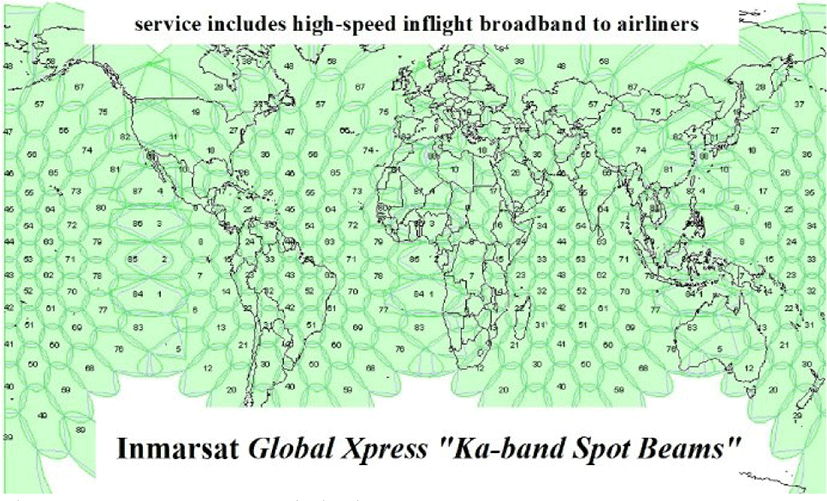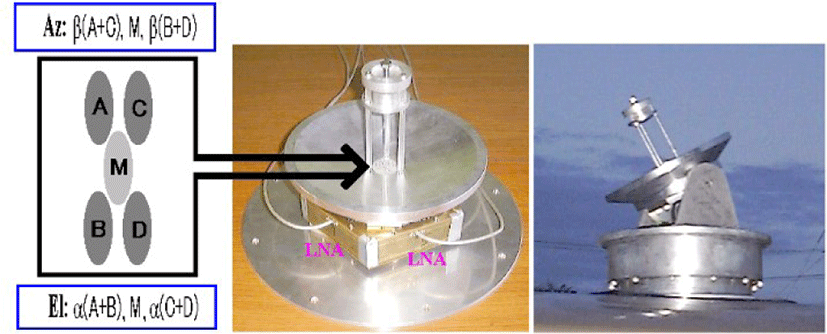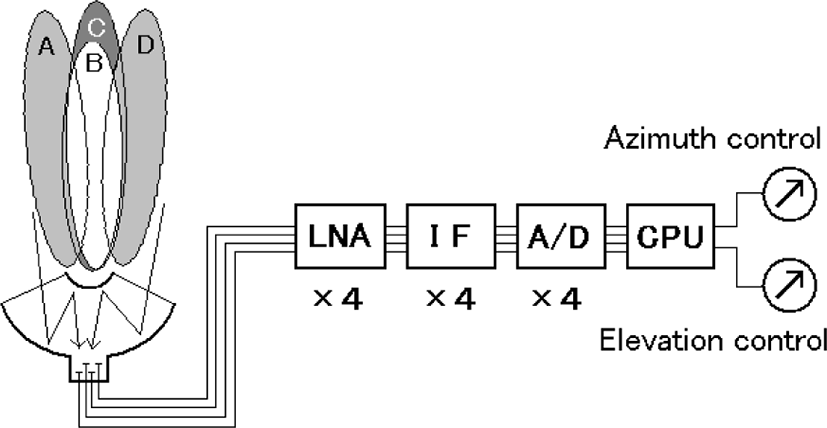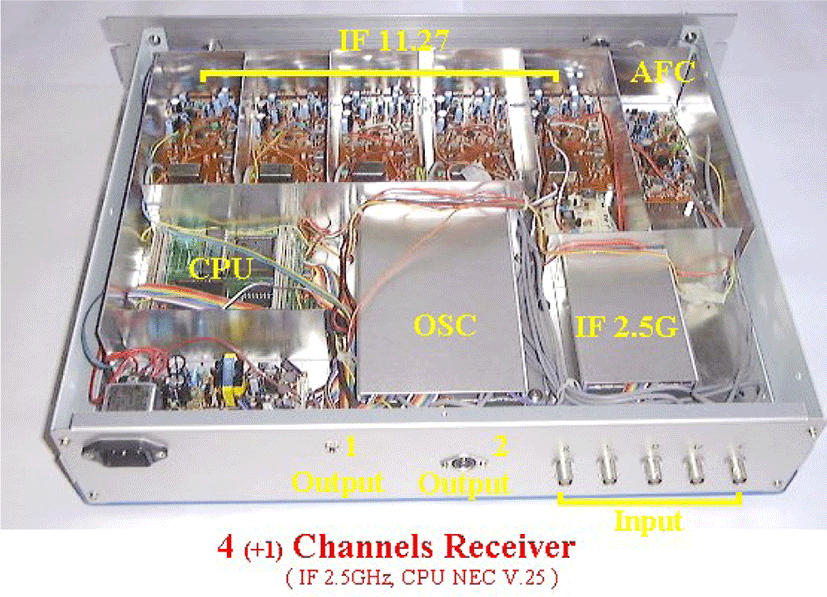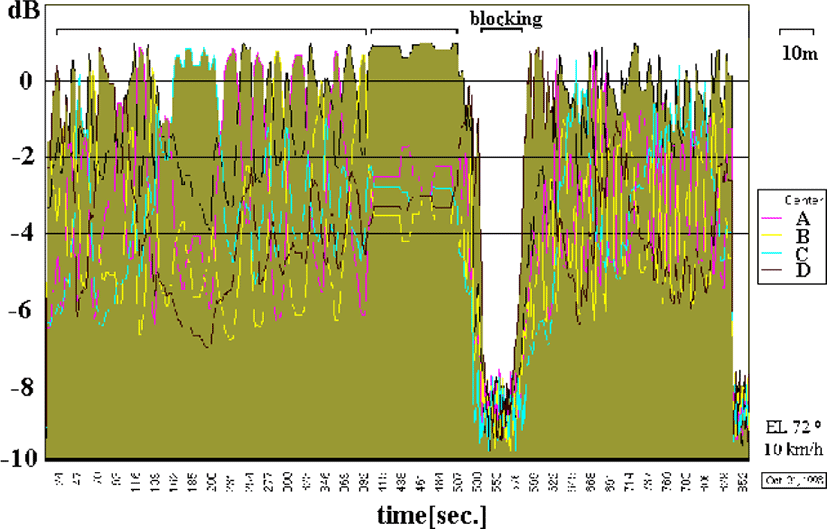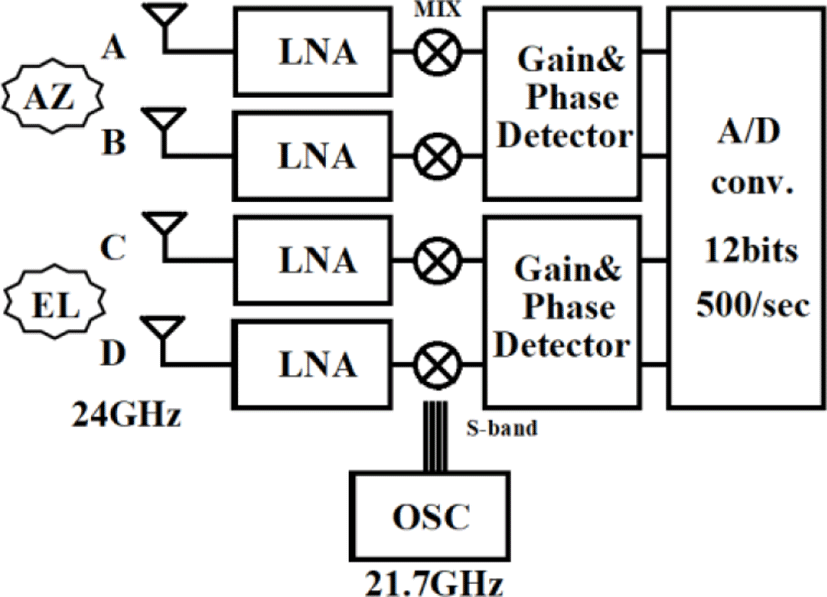I. INTRODUCTION
Tracking the extremely low-energy signal from a moving vehicle is quite difficult if the signal is too weak to be phase-locked. Using the optical-tracking and quadrant-detector technology of the 1960s and 1970s as a basis, we have developed a mobile quadrant detector for millimeter-wave reception. This quadrant detector is comprised of four dedicated feed components for reception, and one transmission and reception feed component. It also uses a Cassegrain reflector antenna system. The half of this report is the results of our past field experiment on 23 GHz of COMETS. In 2018, with new microwave phase difference detector (AD8302), we have verified new QD system with basic experiments and with simulation, these are also included in this report. This new technology shall be improving the tracking abilities from mobile vehicle on the ground to the multimedia satellite.
II. BACKGROUND
According the ITU-R 9.11A, there are some possibility to operate from moving terminal to non-GSO satellite with 29.5GHz for uplink and 19.7GHz downlink with the condition of the epfd (equivalent power flux density) limits. Concerning about parabola type antenna of 60-cm diameter in size, it seems completely that the radiation-axis include side lobs to be satisfied with the ITU-R regulation. The most important technical factors might be how we can track the satellite from the movable body, and how we can stop the wave in an instant when the antenna beam lost the beacon of the target satellite.
The Improvement in the data speed of mobile communications service is put in practical use by Inmarsat Global Xpress (Figure 1) that was started the service in 2016. This service includes high-speed inflight broadband to airliners. The Ka band service are supported by the integration of an L-band Fleet Broad Band (FBB) backup service. In this way reliability will not be compromised in case of heavy rain fades at the Ka-band. The Global Xpress will to a large extent replace C- and Ku-band VSAT services across the globe – maritime, land, aviation and government. It seems that the license for land moving vehicle will be issued in future when the Inmarsat and the telecom authority could agree upon some regulatory limitation on Ka-band.
Our ultimate goal is to achieve high-speed multimedia digital communication via satellite from ambulances. To attain this objective, we first assume situations in which patient conditions are transmitted in the form of real-time multimedia data such as digital motion picture to a satellite while the vehicle is in motion. In this case, we are requested that the high-precision of calculating the azimuth and elevation angle to the target satellite using QD, because there are Recommendations of ITU-R to reduce the interference to adjoining satellites. Additionally, the pilot signal from CS (Communications Satellite) will be very weak comparison with BS (Broadcast Satellite). It is because the level of the flux density on the ground from BS and from CS is different. Our task is a development of the QD system on moving vehicle to detect the very weak signal from CS and to calculate the suitable azimuth and elevation angle.
The multimedia data containing patient’s video in an ambulance needs to continue transmitting to an emergency medical center continually via CS, and the technology which continues data follows to CS satellite is required without stopping an ambulance.
An older method for locating radio signal sources relied on the Direction Finder method using a loop antenna. Although this method is effective only when the signals are relatively strong and frequencies are low - from LF (Low Frequency) to (Ultra High Frequency) - it has been widely used on marine vessels. One method for tracking satellites with Ku or pseudo-millimetric waves is already in use. This is accomplished by comparing phase differences with a relatively strong signal. Examples would include mobile BS receivers and tracking devices. But with the CS, allocating sufficient EIRP (Equivalent Isotropically Radiated Power) presents problems. Consequently, signals from CS tend to be lower in reception power than that of a BS, making phase-locking quite difficult.
And the size of the antenna that can be mounted on a moving vehicle is limited. It seems that there is a physical limitation to cover all the roofs of vehicles with phased array antennas.
The following three factors become critical when receiving relatively weak satellite signals on a moving vehicle:
If multiple feed components are to be used, they must be thrown out of focus optically and the entire area that is occupied by feed components broadened. To reduce spatial distortion so that they will become in-phase, we must extend the distance from the reflector surface to the focal point. However, both the relationship between body mass and wind pressure and the relationship between the heavy LNA and the antenna’s moment of inertia inhibit the creation of distance from the reflector on moving vehicles. Given these factors, which hinder mechanical control of the antenna, we believe a Cassegrain reflector antenna incorporating sub-reflector plates is the optimal choice for moving vehicles.
III. METHODS
COMETS is a research and development satellite that targets the development of new techniques in communications and broadcasting areas such as inter-orbital communications, advanced satellite broadcasting, advanced mobile satellite communications, and upgrades of large geostationary satellites. COMETS was launched February 21, 1998, from Tanegashima Space Center. But 24 minutes into its launch, the second-stage rocket engine (LE-5A) on the H-2 rocket malfunctioned on the second burn, preventing placement of COMETS into the stationary transfer orbit originally planned. Total of seven attempts were made to place COMETS on a nine-orbit, quasi-recurrent orbit by making orbital corrections using the apogee motor over two days. COMETS was finally placed in the super elliptical orbit described below. While COMETS is in this orbit and when a person views the satellite from a geographical location of 30 degrees north latitude, the satellite can be viewed directly overhead as it approaches its apogee altitude(Fig.1).
| Apogee altitude | 17,711 Km |
| Perigee altitude | 473 Km |
| Inclination | 30.1 degrees |
| Orbital period | 319 minutes |
Despite the launch failure, ex-NASDA (National Space Development Agency of Japan) and the Ministry of Posts and Telecommunications have called on corporations and universities to continue satellite testing programs. The School of Medicine at Tokai University complied by performing a tracking experiment with a land vehicle, using the 23 GHz beacon of the ICE (Inter-orbit Communications Equipment) on board COMETS.
The ICE forward beacon is originally a pilot signal directed toward an orbiting LEO (Low Earth Orbiter). The pilot signal was designed for outer space applications, an ideal environment due to the absence of noise and vibration. The signal strength is just barely strong enough to permit tracking. Its specifications are as follows:
Receiving this signal on the ground using a 30 cm parabolic antenna would result in a signal reception of no more than C/No = 46 dBHz. Such levels imply signal strength comparable to analog audio signal demodulation. Of course, the received signal is subject to Doppler shift, depending on satellite position, receiving position, and satellite velocity.
Detection of weak signals from satellites may be regarded as a problem of detecting known signals embedded in noise. When isolating satellite signals from the noise, we rely on the fact that the signals are in-phase, whereas noise is random and uncorrelated. Setting up a receiver to receive and add signals for a certain preset time duration (t) would enable in-phase signals to be added while sifting out signals without correlation. A receiver equipped with this type of circuitry is called a heterodyne receiver. In principal, in order to make this weak signal rise from a noise, the integration of the signal of the direction of a time-axis is one technique. Since a received signal is the phase, the electric power P is the square of the received voltage V. If it adds in the direction of a time-axis, it will increase by a quadratic curve by V2. On the other hand, the phase of a noise is random and an expected value is zero. For this reason, even if it adds a noise in time t, it increases only by the route t.
The Quadrant Detector applies this principal. It is constructed of four individual heterodyne receivers (in our case, five channels) on a plane orthogonal to the direction of the radio waves (Z): two along the X-axis and two along the Y-axis, for a total of four receivers. These heterodyne receivers are connected to feed components to detect the flight direction of radio waves (Figure 2-5).
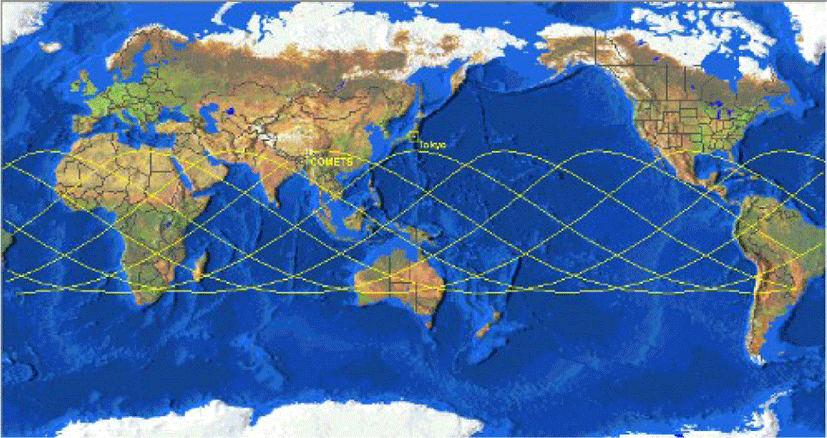
The first method used to locate a satellite. The satellite’s six elements, time, present location (GPS data), and antenna elevation are easily calculated. Optimal positions are sequentially calculated according to bearings (using a laser-gyro).
Comparing and controlling signal strength from a satellite using Quadrant Detector.
After loading the equipment into a van, the experiment was conducted in Takaoka City, Toyama Prefecture. We were successful in receiving a 23 GHz beacon signal from ICE and succeeded in tracking the satellite from a moving vehicle at speeds of approximately 10 ~ 20 Km/h on paved roads (Figure 6).
However, the reception strength fluctuated constantly due to vibrations from the vehicle and from the antenna’s tracking movements. In the future, a better way to absorb vehicle vibration and improved algorithms for antenna control will be required to reduce the effects on the antenna. Nevertheless, we were able to verify the basic operating principals of our QD using ICE on board COMETS.
IV. Next technical approach
In 2018, we chose new digital device AD 8302 which is a certain kind of signal comparator. This integrated circuit measures the gain and the phase differences between two RF input signals from DC to 2.7GHz.
The usable input range for the AD8302 is from -60dBm to 0dBm. The signals extracted from the antenna through LNA and mixer are going to need 80 dB or more of amplification before they can be combined in this device, as the receiving level might be -120dBm to -140dBm. The signals will need to pass through several stages of amplification and bandpass filtering prior to being applied to the AD8302 input ports. One of the beautiful things about this device, however, is that it allows the signal levels of the inputs to vary by a wide range and still present an accurate phase measurement.
As for the simulation of the QD with new digital device, we have designed the prototype board to test its ability. The block diagram of the prototype demonstration board was shown in the Figure 7 and the result of the test of the relationship of gain and the phase shown in the Figure 8. The integrated circuit measures the gain and the phase differences between two RF input signals of the IF(Internal Frequency) at 2.3 GHz. A prototype demonstration board for the gain and phase has been designed to evaluate its capabilities. Operating with the signal level over -60dBm at 2.3GHz, it can detect gain differences from -30 dB to 30 dB and phase differences from -180° to +180°.
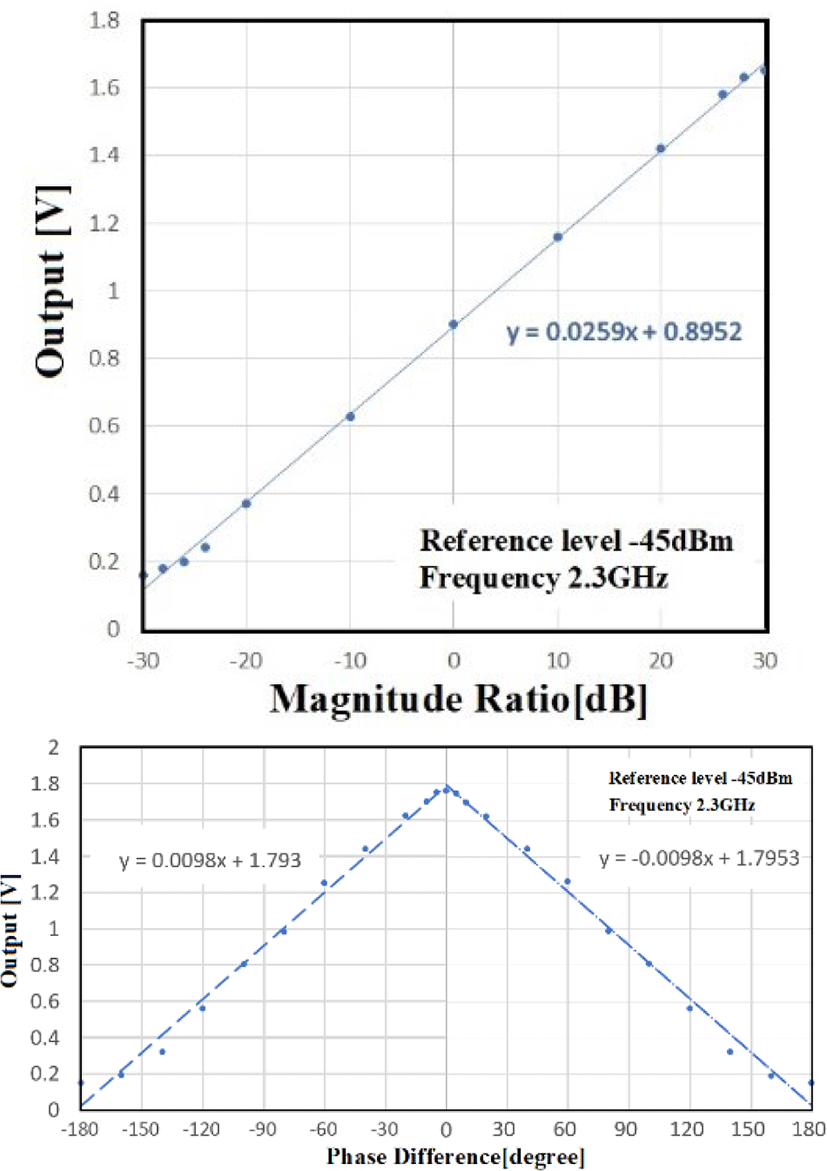
Correlation the analog QD with experiments of COMETS, digital QD (AD8302), each angle error and C/N was shown in the Figure 9.
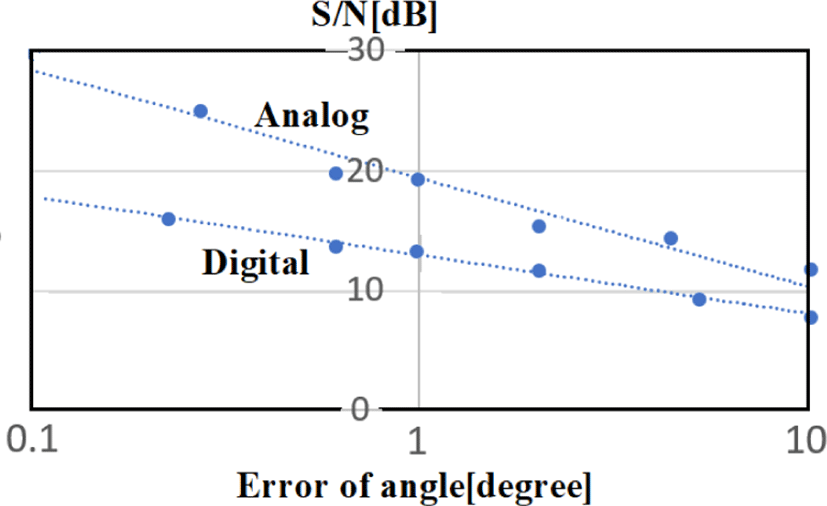
V. CONSIDERATION
A major determining factor in the tracking capabilities of a quadrant detector is the noise (RMS value) resulting from the angle error signals captured by the reception antenna’s feed. This is defined as the Noise Equivalent Angle (NEA).
Microwave transmission between the High Elliptical Orbiter (HEO) multimedia satellite and a mobile station (e.g., a moving ambulance) is a “line of sight” transmission. To isolate and assess QD’s tracking capabilities, we posited a transmission environment in which incoming angle error signals would be insignificant,even if such a special environment is in the Nakagami - Rician fading area due to multi-pathing. The following equations describe this environment:
Gangle: QD’s angle detection gain
S/N: Signal to noise ratio at the feeder’s reception element
The mobile station’s overall tracking system error is given as follows:
δtotal: mobile station’s overall tracking system error
δS: NEA of the mobile station’s tracking device’s tracking device
δV: Directional control errorδV due to, for example, vehicle torque disturbance.
δS is greater than δV when transmission power from the HEO satellite is weak and reception power on the receiving end is inadequate. This indicates that tracking errors are significantly affected by reception power, which varies according to the HEO satellite’s tracking capabilities (antenna’s tracking error to the targeted area on earth) and according to both the satellite’s and the mobile station’s antenna patterns (half-value angles). An analysis of this reciprocal relationship assumes the following:
-
δV and δS are statistically independent. Errors in the direction of both of their orthogonal axes adhere to a Gaussian pattern with identical distributions, although they are statistically independent.
-
Beam patterns for satellite transmissions and mobile receptions both have axisymmetric Gaussian distributions.
-
δV is in the process of achieving steady-state
-
δV is inversely proportional to reception power
In this case, directional errors occur in an axisymmetric Gaussian pattern. By setting the appropriate parameters for the two respective tracking systems (satellite: A, mobile station: B): i.e., NEAs (δSA,δSB) and antenna beam widths (Wa, Wb) we can produce three types of tracking statuses, represented in the diagram as three areas (Figure 10). Areas (1) and (2) represent stable tracking, while area (3) represents unstable tracking. Areas (1) and (2) differ in that the interaction of the two stations is accounted for in one case, but not in the other, suggesting that the stable areas may be reduced as a result of interactions between two stations. In short, it is important to keep the tracking NEA low by dividing its S/N denominator into tenths. One way to achieve this is to reduce the gain angle by adding the incoming signal and noise to the time axis and positioning the four reception feeds off the optical focal point.
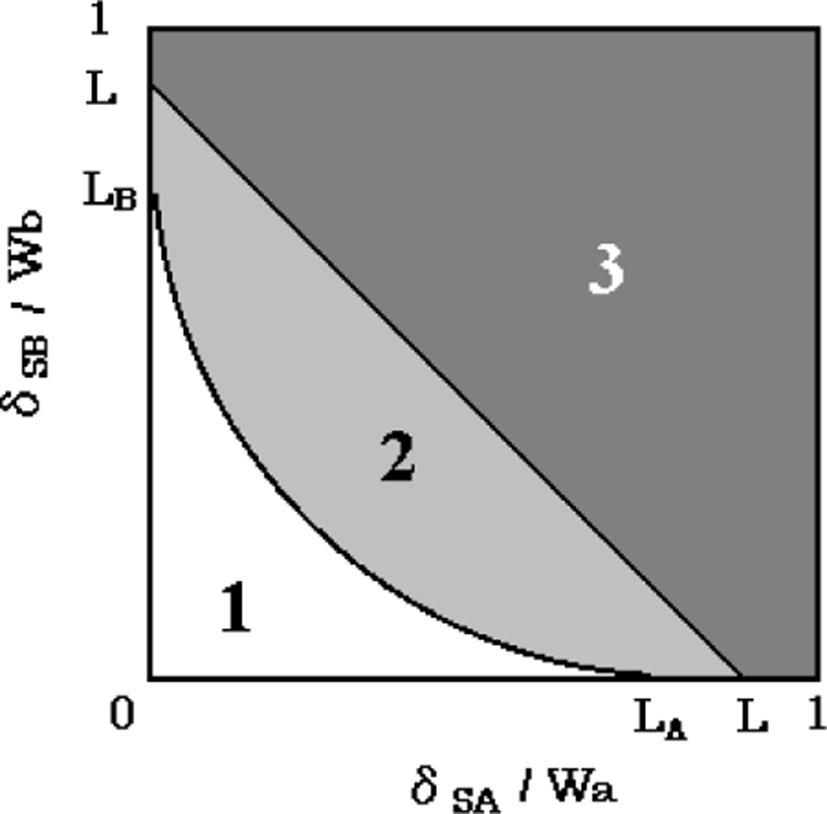
However, our scenario omits many of the most characteristic features of the urban environment, where signals are commonly reflected off tall structures. That is, we have not accounted for the effects of complex multipathing. In such environments, multipath signals can independently strike the four elements of the quadrant detector at angles that significantly deviate from the correct angle. Continuous tracking in such a multipath environment is difficult, even with a quadrant detector (QD). The only countermeasure is to direct the antenna by calculating the relative position of the satellite based on the six elements of the satellite’s orbit and by adding the angle of variance (X, Y, Z) per time as obtained from an optical gyro.
VI. CONCLUSION
Based on the past filed data of the reception experiment with COMETS satellite, we have studied on new device (AD8302, phase difference detector) was acquired and suspect its abilities. Comparison analog v.s. digital, there are remarkable improvement of the error of angle and S/N with AD8302.
The synchronous addition of the signal is carried out in the direction of a time-axis, the QD can improve the S/N. However, there is a limit in obtaining sufficient S/N to track satellite from moving vehicle.
On the other hand, with a digital phase difference detector device AD8302, we can calculate the azimuth and elevation with multiplies by two parameters, magnitude and phase, so the S/N improves very much. This tracking system will be effective to send huge data of multimedia under the propagation environment of Nakagami-Rician fading channel. However, since there are the blocking and shadowing by building or severe multipath environment in urban area, we have to expect the technical development of a highly precise optical gyroscope and GPS compass in the future.
